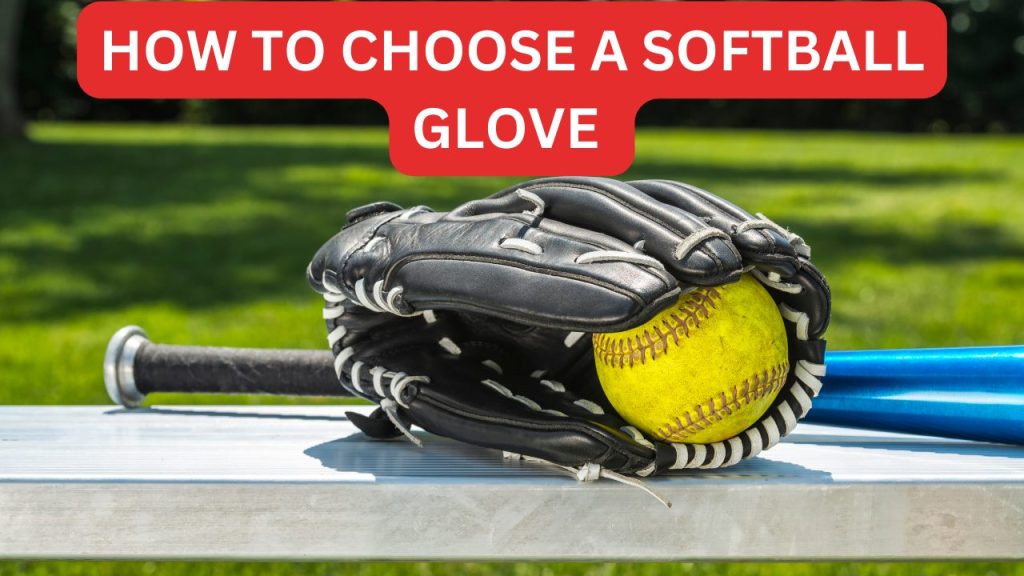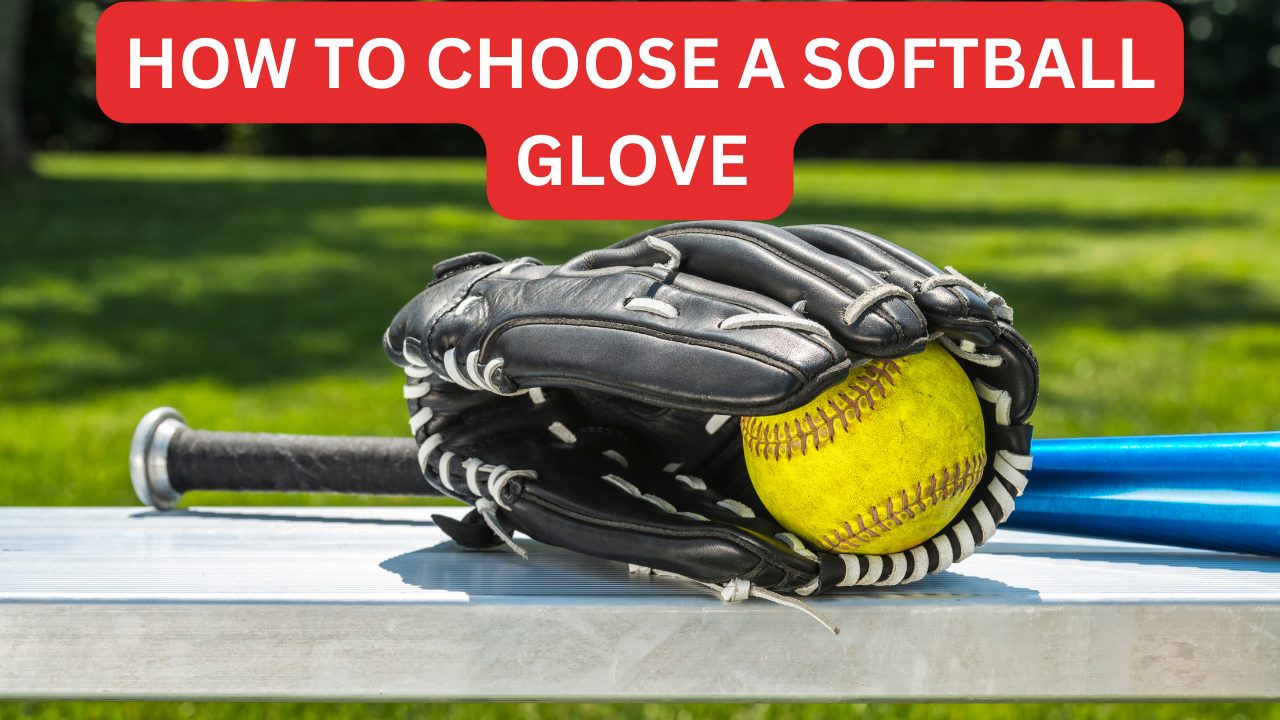Are you tired of dropping catches or feeling uncomfortable while playing softball? Your glove might be the culprit. The best glove can elevate your softball game. But it’s not as simple as choosing the color and size of the glove. It’s about selecting the exact size, personal preferences, material, and features that improve your game performance. In this post, we’ll discuss how to choose a softball glove the right way. We’ll help you to select the best softball glove based on your position, size, and other factors. Get ready to play with confidence!

The Importance Of Choosing A Softball Glove The Right Way
Any softball player who wants to succeed on the field must choose the right glove. It can be challenging to catch, throw, and control the ball with a glove that is either too tight or loose. Depending on the ball’s direction and the player’s motions, each location on the field has unique glove needs. Thus, it’s important to know the many glove styles offered, how to assess the best fit accurately, and what materials suit your demands.
Understanding The Types Of Softball Gloves
There are five primary types of softball gloves: infielder, outfielder, catcher, first baseman, and utility gloves. Infielder gloves are designed with a shallow pocket and a smaller overall size to make quick transfers and throws.
Outfielder gloves have a deeper pocket and longer fingers to help players catch fly balls more easily. Catcher’s gloves have more padding and a closed webbing to protect the player’s hand from fastballs.
First baseman gloves are longer than infielder gloves and have a rounded edge to scoop up ground balls better. Players who play different positions and want flexible gloves employed in different situations may consider utility gloves.
Evaluating The Perfect Size For Your Softball Glove
You’ll need to measure your hand to check the perfect fit for your softball glove. Consider position-specific factors and try on different gloves. Measuring your hand will give you a general idea of your desired glove size. Try several gloves to see what feels comfortable and fits your hand and position best.
How To Measure Glove Size
The most crucial factor when choosing a softball glove is the size. Use a flexible measuring tape to determine the distance between the tip of your index finger and the beginning of your wrist, where the base of the glove rests. It will give you your ideal softball glove size in inches.
For example, if you determine 11 inches from your index finger to your wrist, you should look for a glove that is 11 inches long. But, this is not a hard and fast rule, as different positions may need different glove sizes.
Infielders and pitchers may prefer smaller gloves for better control and quicker transfers. While outfielders may prefer larger gloves for more reach and coverage. Thus, when choosing a glove, consider your position when choosing your size.
How To Choose A Softball Glove The Right Way
Softball glove is necessary for everyone, regardless of position and ability level. So it is important to choose a softball glove the right way because it affects your game performance on the field.
Selecting a softball is not as simple as fitting your needs and budget. Consider multiple factors such as size, position, material, and webbing. Besides the size, there are other features that you should look for when choosing a softball glove, such as:
Webbing
The webbing is part of the glove that connects the fingers and the thumb. It secures the ball in the pocket and affects the visibility and flexibility of the glove. Different types of webbing have different features and purposes.
Closed webbing gives more support and concealment. Open webbing gives more visibility and breathability, and basket webbing gives extra versatility and stability. While H-webbing also provides more durability and flexibility.
The pocket is part of the glove where the ball is caught and held. It affects the depth and shape of the glove and influences how easy it is to catch and release the ball. Different pockets have different benefits and uses.
Shallow pockets are suitable for fast throws and infielders, and deep pockets are good for secure catches and outfielders. While Round pockets are good for control and pitchers, and flat pockets are suitable for capability and first basemen.
Choosing the Material of Your Softball Glove
The three most common materials for softball gloves are leather, synthetic, and hybrid. Leather gloves are most commonly used in softball for durability and flexibility. Synthetic gloves are typically less expensive and need less time to break in.
Hybrid gloves combine leather and synthetic materials, creating a durable and flexible option. The material choice will depend on your budget, personal preferences, and the time you dedicate to breaking in the glove.
Padding and protection
The padding is part of the glove that cushions your hand from the ball’s impact. It affects the comfort and protection of the glove and influences how much you feel the ball in your hand.
Different padding has different effects and benefits. Foam padding absorbs shock and feels comfortable; wool padding keeps the shape and gives stability. Felt padding allows movement and reacts quickly.
Wrist Adjustments
The better your wrist adjustment better you perform in the game because it protects your hand from fastball impacts and injuries. You feel more comfortable, secure, and easily put in and off the softball glove. Different wrist adjustments include velcro straps, laces, and buckles used for this purpose.
How To Break In A Softball Glove | Tips & Techniques
Once you have chosen your softball glove, break it in before using it in a game. Breaking in a glove makes it more flexible, comfortable, and responsive to your hand movements. A new glove will be stiff, tight, and hard to close, affecting your performance and confidence on the field. There are different methods of breaking in a softball glove, such as:
Applying Oil or Conditioner
Apply a leather conditioner or oil to the glove. It helps to increase its flexibility and soften it. You can use glove oil or olive oil with vinegar but avoid harmful chemical conditioners.
Playing Catch
Playing catch is another great way to break in your glove. Try to play catch every day for a week using your new glove. It will help the leather stretch and form your hand’s shape.
Using a Glove Mallet
A glove mallet is a tool that you can use to help shape your glove. It’s a small hammer or mallet with a curved head that you can use to pound the pocket of your glove to make it deeper. It benefits infielders who need a deep pocket to catch and scoop ground balls.
Using Heat
Breaking in a softball glove To lose the leather material and increase its flexibility, use heat. For this purpose, heat sources such as ovens, microwaves, and hairdryers are used. But you should become more conscious about burning or melting the glove’s material. Because too much heat can burn or dry the leather, keep an eye on temperature and time.
HOW TO Choose A Softball Glove For Your Position
Now you know all the key features and important information about choosing a softball glove the right way. So next we talk about how to choose the right glove for your specific position:
Infielders
Infielders need a glove with a deeper pocket and a smaller size for faster ball transfer. Look for a glove with a closed web and moderate padding for added protection.
Outfielders
Outfielders need a larger glove with a shallower pocket for quicker catches and throw. Look for a glove with an open web and minimal padding for greater flexibility.
Catchers
Catchers need a specialized gloves with extra padding and protection to absorb the impact of fastballs. Look for a glove with a closed web and a deep pocket.
First Basemen
First basemen need a larger glove with a deep pocket and a longer reach for catching balls thrown from infielders. Look for a glove with a closed web and minimal padding for greater flexibility.
Utility Players
Utility players need versatile gloves that can use for many positions. Look for a glove with a moderate pocket depth and a closed web for added flexibility.
Tips For Maintaining & Caring for Your Softball Glove
After you have broken in your softball glove, you need to care for it properly to maintain its quality and longevity. Caring for a glove means keeping it clean, dry, conditioned, and stored correctly. A well-cared-for glove will last longer, perform better, and look nicer than a neglected one. Here are some tips and tricks for maintaining and caring for your Softball glove:
- Use a soft cloth to clean your softball glove regularly
- Store your softball glove in a cool, dry space when it is not in use
- After cleaning your glove, leave it to dry in the air naturally
- To maintain the shape of your glove, don’t leave it in the closed position
- Avoid using your softball glove in other sports
- Keep your glove tip-top shape using a conditioner explicitly made for softball gloves.
Now you clear your confusion on how to choose a softball glove the right way. To get the help of this guide, you can select the glove that suits your needs. But remember all the crucial points like material, size, position, and skill level when you choose a glove. With the best glove, you can improve your performance and enjoy more.

